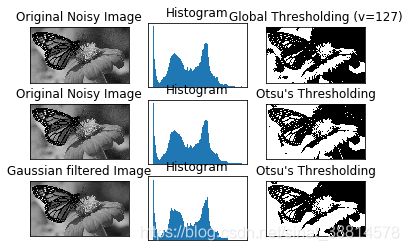OpenCV_Python官方文档11——图像阈值
OpenCV-Python Tutorials
https://opencv-python-tutroals.readthedocs.io/en/latest/py_tutorials/py_tutorials.html
阈值(二值化操作),阈值又叫临界值,是指一个效应能够产生的的最低值或最高。
简单阈值
选取一个全局阈值,整个图像都和这个阈值比较,然后就把整幅图像分成了非黑即白的二值图像。
主要函数
ret, dst = cv2.threshold(src, thresh, maxval,type)
dst: 输出图像src: 输入图像,只能输入单通道图像,一般为灰度图thresh: 阈值maxval: 当像素值大于阈值(或者小于阈值,根据type来决定),所赋予的值type:阈值操作的类型- cv2.THRESH_BINARY #二元阈值
- cv2.THRESH_BINARY_INV #逆二元阈值
- cv2.THRESH_TRUNC
- cv2.THRESH_TOZERO
- cv2.THRESH_TOZERO_INV
import cv2
import numpy as np
import matplotlib.pyplot as plt
import os
os.chdir('C:/Users/lenovo/Pictures/')
img = cv2.imread('butterfly.jpg',0) #读取图片并直接将图像灰度化
ret,thresh1 = cv2.threshold(img,127,255,cv2.THRESH_BINARY) #如果一个像素值低于127,则像素值转换为255(白色色素值),否则转换成0(黑色色素值)
ret,thresh2 = cv2.threshold(img,127,255,cv2.THRESH_BINARY_INV)
ret,thresh3 = cv2.threshold(img,127,255,cv2.THRESH_TRUNC)
ret,thresh4 = cv2.threshold(img,127,255,cv2.THRESH_TOZERO)
ret,thresh5 = cv2.threshold(img,127,255,cv2.THRESH_TOZERO_INV)
titles = ['Original Image','BINARY','BINARY_INV','TRUNC','TOZERO','TOZERP_INV']
imgs = [img,thresh1,thresh2,thresh3,thresh4,thresh5]
for i in range(len(imgs)):
plt.subplot(2,3,i+1)
plt.imshow(imgs[i],'gray')
plt.title(titles[i])
plt.axis('off')
plt.show()
自适应阈值
局部性阈值,根据图像上的每一个小区域计算与其对应的阀值。通过规定一个区域大小,比较这个点与区域大小里面像素点的平均值(或者其他特征)的大小关系确定该像素点的值。因此在同一幅图像上的不同区域采用的是不同的阀值,从而使我们能在亮度不同的情况下得到更好的结果。
主要函数
dst = cv2.adaptiveThreshold(src, maxval, thresh_type, type, Block Size, C)
dst: 输出图像src: 输入图像,只能输入单通道图像,一般为灰度图maxval: 当像素值大于阈值(或者小于阈值,根据type来决定),所赋予的值thresh_type: 阈值计算方法- cv2.ADAPTIVE_THRESH_MEAN_C #阀值取邻域的平均值
- cv2.ADAPTIVE_THRESH_GAUSSIAN_C #阀值取邻域的加权和,权重为一个高斯窗口
type:阈值操作的类型- cv2.THRESH_BINARY #二元阈值
- cv2.THRESH_BINARY_INV #逆二元阈值
- cv2.THRESH_TRUNC
- cv2.THRESH_TOZERO
- cv2.THRESH_TOZERO_INV
Block Size: 计算阈值的区域大小C:阈值计算方法中的常数项,阈值等于均值或者加权值减去这个常数C
import cv2
import numpy as np
import matplotlib.pyplot as plt
import os
os.chdir('C:/Users/lenovo/Pictures/')
img = cv2.imread('butterfly.jpg',0) #读取图片并直接将图像灰度化
#中值滤波 起到平滑图像,滤去噪声的作用
img = cv2.medianBlur(img,5)
ret,th1 = cv2.threshold(img,127,255,cv2.THRESH_BINARY) #11为block size,2为C
th2 = cv2.adaptiveThreshold(img,255,cv2.ADAPTIVE_THRESH_MEAN_C,cv2.THRESH_BINARY,11,2)
th3 = cv2.adaptiveThreshold(img,255,cv2.ADAPTIVE_THRESH_GAUSSIAN_C,cv2.THRESH_BINARY,11,2)
titles = ['Original Image','global thresholding(v=127)','Adaptive mean thresholding','Adaptive gaussian thresholding']
imgs = [img,th1,th2,th3]
for i in range(len(imgs)):
plt.subplot(2,2,i+1)
plt.imshow(imgs[i],'gray')
plt.title(titles[i])
plt.axis('off')
plt.show()
输出结果: 上述阈值区域大小设置为11,当窗口越小,得到的图像越细。
Otsu 二值化
最大类间方差法是由日本学者大津于1979年提出的,是一种自适应的阈值确定的方法,又叫大津法,简称OTSU。
cv2.threshold()是有两个返回值的,前面一直用的第二个返回值,也就是阈值处理后的图像,那么第一个返回值(得到图像的阈值)将会在这里用到。
前面对于阈值的处理上,我们选择的阈值都是127,那么实际情况下,怎么去选择这个127呢?有的图像可能阈值不是127得到的效果更好。那么这里需要算法自己去寻找到一个阈值,而Otsu就可以自己找到一个认为最好的阈值。并且Otsu非常适合于图像灰度直方图具有双峰的情况,他会在双峰之间找到一个值作为阈值,对于非双峰图像,可能并不是很好用。那么经过Otsu得到的那个阈值就是cv2.threshold()的第一个参数了。因为Otsu方法会产生一个阈值,那么函数cv2.threshold()的的第二个参数(设置阈值)就是0了,并且在cv2.threshold()的方法参数中还得加上语句cv2.THRESH_OTSU。
Otsu过程:
- 计算图像直方图;
- 设定一阈值,把直方图强度大于阈值的像素分成一组,把小于阈值的像素分成另外一组;
- 分别计算两组内的偏移数,并把偏移数相加;
- 把0~255依照顺序多为阈值,重复1-3的步骤,直到得到最小偏移数,其所对应的值即为结果阈值。
绘制直方图
plt.hist(src,pixels)
- src:数据源,注意这里只能传入一维数组,使用src.ravel()可以将二维图像拉平为一维数组。
- pixels:像素级,一般输入256。
import cv2
import numpy as np
import matplotlib.pyplot as plt
import os
os.chdir('C:/Users/lenovo/Pictures/')
img = cv2.imread('butterfly.jpg',0) #读取图片并直接将图像灰度化
#Global Thresholding
ret1,th1 = cv2.threshold(img,127,255,cv2.THRESH_BINARY)
#Otsu's Thresholding
ret2,th2 = cv2.threshold(img,0,255,cv2.THRESH_BINARY+cv2.THRESH_OTSU)
#Otsu's Thresholding after Gaussian Filtering 高斯滤波
blur = cv2.GaussianBlur(img,(5,5),0) #(5,5)为高斯内核大小,0为标准偏差
ret3,th3 = cv2.threshold(blur,0,255,cv2.THRESH_BINARY+cv2.THRESH_OTSU)#阈值设为0
#plot all the images and their histograms
imgs = [img,0,th1,img,0,th2,blur,0,th3]
titles = ['Original Noisy Image','Histogram','Global Thresholding (v=127)',
'Original Noisy Image','Histogram',"Otsu's Thresholding",
'Gaussian filtered Image','Histogram',"Otsu's Thresholding"]
for i in range(3):
plt.subplot(3,3,i*3+1),plt.imshow(imgs[i*3],'gray')
plt.title(titles[i*3]),plt.xticks([]),plt.yticks([])
plt.subplot(3,3,i*3+2),plt.hist(imgs[i*3].ravel(),256)
plt.title(titles[i*3+1]), plt.xticks([]), plt.yticks([])
plt.subplot(3,3,i*3+3),plt.imshow(imgs[i*3+2],'gray')
plt.title(titles[i*3+2]), plt.xticks([]), plt.yticks([])
plt.show()
print (ret2)
输出结果: 用Otsu算出的阈值为98


